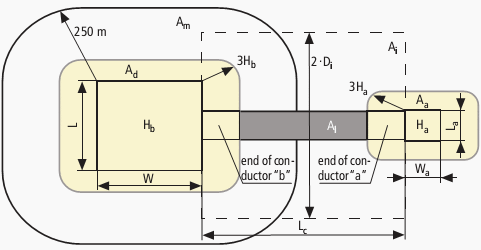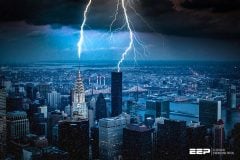
Frequency of lightning strikes
We distinguish between the following frequencies of lightning strikes which can be relevant for a building or structure:
- ND – Frequency of direct lightning strikes to the building or structure;·
- NM – Frequency of close lightning strikes with electromagnetic effects;
- NL – Frequency of direct lightning strikes in utility lines entering the building or structure;
- NI – Frequency of lightning strikes adjacent to utility lines entering the building or structure.
The calculation of the frequencies of lightning strikes is given in detail in Annex A of IEC 62305-2 (EN 62305-2).
If a finer grid is used, the local values of the lightning densities can still deviate noticeably from these averages. Owing to the relatively short time of seven years the map has been recorded, and to the large area averaging according to licence plate number areas, the application of a safety factor of 25 % to the values given in Figure 1 is recommended.

For the frequency of directlightning strikes ND to the building or structure we have:
ND = Ng · Ad · Cd · 10-6
Ad is the equivalent interception area of the isolated building or structure (Figure 2), Cd a site factor so that the influence of the surroundings (built-up, terrain, trees, etc.) can be taken into account (Table 1).
Similarly, the frequency of close lightning strikes NM can be calculated:
NM = Ng · Am · 10-6
Table 1 – Site factor Cd
| Relative site of the building or structure | Cd |
| Object is surrounded by higher objects or trees | 0.25 |
| Object is surrounded by objects or trees of the same or lower height | 0.5 |
| Free-standing object: no further objects near by (within a distance of 3H) | 1 |
| Free-standing object on top of a moutain or a rounded hilltop | 2 |


Table 2 – Equivalent interception areas Al and Ai in m2
| Overhead line | Underground cable | |
| Al | [ Lc – 3 · (Ha + Hb) ] · 6 · Hc | [ Lc – 3 · (Ha + Hb) ] · 6 · √ρ |
| Ai | 100 · Lc | 25 · Lc · √ρ |
Table 3 – Environment factor Ce
| Environment | Ce |
| Urban with high buildings or structures (higher than 20 m) | 0 |
| Urban (buildings or structures of heights between 10 m and 20 m) | 0.1 |
| Suburban (buildings or structures not higher than 10 m) | 0.5 |
| Rural | 1 |
Nl = Ng · Ai · Ct · Ce · 10-6
The area Ai (Figure 3) is again a function of the type of line (overhead line, underground cable), the length LC of the line; in the case of cables, it is a function of the earth resistivity ρ; and for overhead lines it is a function of the height HC of the line above ground level (Table 3).
The correction factors Ct and Ce correspond to those already stated above. The frequency Nl must then also be determined individually for each utility line entering the building or structure.
Close Up Lightning Strike Compilation (VIDEO)
Reference: Lightning Protection Guide – Dehn











Dear Edward,
can you share any guidelines for the lightning protection for metal chimney having 64,86 mtrs height how to decide size of the air terminals , horizontal terminals and down comers etc [email protected] is my email id